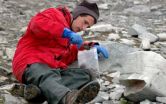(Press-News.org) Infants as young as nine months old prefer individuals who are nice to people like them and mean to people who aren't like them, according to a new study published in Psychological Science, a journal of the Association for Psychological Science.
In our social lives, we tend to gravitate toward people who have things in common with us, whether it's growing up in the same town, disliking the same foods, or even sharing the same birthday. And research suggests that babies evaluate people in much the same way, preferring people who like the same foods, clothes, and toys that they like.
This preference helps us to form social bonds, but it can also have a dark side. Disliking people who are different than us may lead us to mistreat them, and excuse – or even applaud – cases in which others mistreat people who are different than us.
Are the roots of such tendencies present in infancy?
To find out, psychological scientist Kiley Hamlin, now a professor at the University of British Columbia, conducted two studies as a graduate student at Yale University with her advisor Karen Wynn and colleagues.
The researchers had 9- and 14-month-old infants choose which food they preferred: graham crackers or green beans. The infants then watched a puppet show in which one puppet preferred graham crackers, while another preferred green beans. That is, one puppet demonstrated that its food preference was the same as the infant's, while the other demonstrated that its food preference was different from the infant's.
After the puppets chose their foods, infants then watched another puppet show, in which either the similar puppet or the dissimilar puppet dropped its ball and wanted it back. On alternating events, infants saw that one character always helped the ball-less puppet by returning the ball to him, while another character always harmed the ball-less puppet by stealing the ball away.
Finally, infants were given the chance to choose between the helper (giving) and harmer (stealing) puppets (videos of the experimental procedure are available at http://cic.psych.ubc.ca/Media_Videos.html) .
Unsurprisingly, infants' choices revealed that almost all the infants in both the 9- and 14-month-old groups preferred the character who helped the similar puppet over the character who harmed the similar puppet. Previous research has shown that infants like people who are nice to totally unknown individuals, so it makes sense that they would also like people who are nice to individuals who are similar to them.
Far more surprising was that almost all the infants at both ages preferred the character who harmed the dissimilar puppet over the character who helped him. Infants' preference for those who harmed dissimilar others was just as strong as their preference for those who helped similar ones.
According to Hamlin, these findings suggest that "like adults, infants incorporate information about not only what people do (e.g., acting nicely or meanly) but also whom they do it to (e.g., a person who is liked or disliked) when they make social evaluations."
The researchers confirmed these results in a second experiment, which included a neutral puppet that had demonstrated no food preference and no helpful or harmful behaviors.
This time, the 14-month-olds – but not the 9-month-olds – preferred the character that harmed the dissimilar puppet over the neutral puppet, and the neutral puppet over the helper of the dissimilar puppet. These results suggest that when a dissimilar individual is in need, 14-month-olds generate both positive feelings toward those who harm that individual and negative feelings toward those who help him. The researchers suggest that between 9 and 14 months, infants develop reasoning abilities that lead to these more nuanced social evaluations.
These results highlight the fundamental mechanisms that underlie our interactions with similar and dissimilar people.
"The fact that infants show these social biases before they can even speak suggests that the biases aren't solely the result of experiencing a divided social world, but are based in part on basic aspects of human social evaluation," says Hamlin.
But the exact reasons for infants' biased evaluations are still unknown.
"Infants might experience something like schadenfreude at the suffering of an individual they dislike," Hamlin notes. "Or perhaps they recognize the alliances that are implied by social interactions, identifying
an "enemy of their enemy" (i.e., the harmer of a dissimilar puppet) as their friend."
Hamlin emphasizes that even if these kinds of social biases are "basic," it doesn't mean that more extreme outcomes, like xenophobia and intergroup conflict, are inevitable.
"Rather, this research points to the importance of socialization practices that recognize just how basic these social biases might be and confront them head-on," she concludes.
###
Co-authors on this research include Neha Mahajan of Temple University, Zoe Liberman of the University of Chicago, and Karen Wynn of Yale University.
This research was supported by National Science Foundation Grant BCS-0921515 and National Institutes of Health Grant R01-MH-081877 to Karen Wynn.
Videos of the experimental procedure are available at: http://cic.psych.ubc.ca/Media_Videos.html
For more information about this study, please contact: Kiley Hamlin at kiley.hamlin@psych.ubc.ca or Karen Wynn at karen.wynn@yale.edu.
The APS journal Psychological Science is the highest ranked empirical journal in psychology. For a copy of the article "Not Like Me = Bad: Infants Prefer Those Who Harm Dissimilar Others" and access to other Psychological Science research findings, please contact Anna Mikulak.. END
The energy produced by solar panels, be it heat or electricity, has to be used right away. It is hard to store and preserve and also its transportation can be rather complicated. Creating solar cells capable of producing energy in an easily storable and transportable way, that is to say fuel, is therefore the future challenge of solar energy. For this reason the scientists at SISSA are working on a catalyst that imitates and improves what nature has been able to do for millions of years.
Plants turn solar energy into sugars, the true "green" fuel, through photosynthesis. ...
PROVIDENCE, R.I. – A new study by a Rhode Island Hospital researcher has found it's possible to maintain high-quality CT colonography diagnostic images while reducing the radiation dose. This is important as the use of CT colonography, or virtual colonoscopy, becomes more widely used for colorectal cancer screenings.
Through his research, Kevin J. Chang, M.D., of the department of diagnostic imaging, found that decreasing the tube voltage would not negatively impact the integrity of the CT colongraphy. His research is published in the current issue of the journal Radiology.
"Radiation ...
GAINESVILLE, Fla. --- Butterflies are among the most vibrant insects, with colorations sometimes designed to deflect predators. New University of Florida research shows some of these defenses may be driven by enemies one-tenth their size.
Since the time of Darwin 150 years ago, researchers have believed large predators like birds mainly influenced the evolution of coloration in butterflies. In the first behavioral study to directly test the defense mechanism of hairstreak butterflies, UF lepidopterist Andrei Sourakov found that the appearance of a false head – a wing ...
A century old mystery as to why, for some animals, it's the father rather than the mother that takes care of their young has been cracked by scientists at the University of Sheffield and University of Bath.
Researchers from the University, in collaboration with the University of Bath and Veszprém (Hungary) found that role reversal was caused by an imbalance in the numbers of males relative to females.
The findings have been published in the journal Nature Communications.
Darwin noted in 1871 that in most animals, it is the females that spend most time looking after ...
An additional 1,000 patients could undergo kidney transplants in the United States annually if hospitals performed more transplants using paired kidney exchanges, new Johns Hopkins research suggests.
Also known as kidney chains, paired kidney exchanges, which allow incompatible donors to give a kidney on a loved one's behalf and ensure that loved one gets a compatible kidney from a third party — usually a stranger — in return, have become much more common since 1999 when The Johns Hopkins Hospital pioneered the practice. But the dramatic growth in the use of these exchanges ...
Researchers have determined a way to predict and protect against new strains of the flu virus, in the hope of improving immunity against the disease.
Influenza is a rapidly spreading acute respiratory disease. Worldwide, annual seasonal epidemics of the flu result in 3-5 million cases of severe illness, and up to 500 000 deaths. A newly emerged virus can spread across 74 countries in 2 months.
The study led by the University of Melbourne with Monash University and international colleagues has found how to predict and potentially stop the mutating cells of the influenza ...
Although they live in similarly extreme ecosystems at opposite ends of the world, Antarctic insects appear to employ entirely different methods at the genetic level to cope with extremely dry conditions than their counterparts that live north of the Arctic Circle, according to National Science Foundation- (NSF) funded researchers.
Writing in the Proceedings of the National Academy of Sciences, the researchers concluded, "Polar arthropods have developed distinct... mechanisms to cope with similar desiccating conditions."
The researchers noted that aside from the significance ...
New Rochelle, NY, March 12, 2013—The foodborne bacteria Listeria monocytogenes sickens about 2,500 people in the U.S. each year and many more worldwide, killing about 25-30% of those infected. Listeriosis is caused by eating food contaminated with L. monocytogenes, and current methods for detecting the bacteria are costly and time consuming. An innovative nanotechnology-based method for developing an inexpensive biosensor to detect the pathogen in food is described in Industrial Biotechnology, a peer-reviewed journal from Mary Ann Liebert Inc., publishers (http://www.liebertpub.com). ...
ANN ARBOR, Mich. — The skin cancer growing on Carolyn Bohlmann's nose was not a very aggressive variety. But it was deep and located right on her nostril. The tricky part was not so much removing it – MOHS surgery, the procedure Bohlmann had, is a fairly common outpatient procedure.
The tricky part would be reconstructing her nostril so that it didn't lift up or droop down. It's an important cosmetic issue, but it's also critical for breathing.
Bohlmann opted for a new reconstruction technique her surgeon, Jeffrey Moyer, M.D., was offering at the University of Michigan ...
ANN ARBOR— Cryptic comments seem to have an ambiguous, obscure or hidden meaning. In biology, cryptic species are outwardly indistinguishable groups whose differences are hidden inside their genes.
Two University of Michigan marine biologists have identified three cryptic species of tiny clams, long believed to be members of the same species, which have been hiding in plain view along the rocky shores of southern Australia for millions of years.
The unusual convergence of a climate-cooling event and the peculiarities of local geography caused the three cryptic species ...


